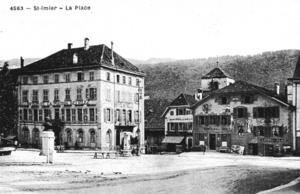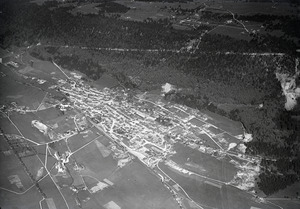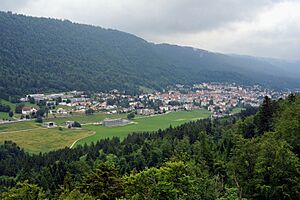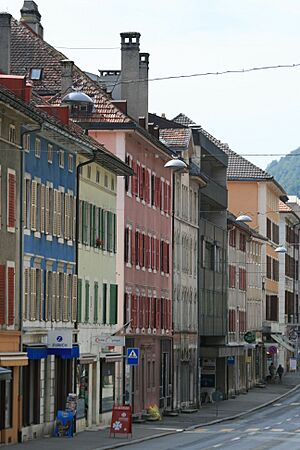Saint-Imier facts for kids
Quick facts for kids
Saint-Imier
|
||
|---|---|---|
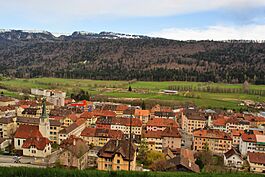 |
||
|
||
| Country | Switzerland | |
| Canton | Bern | |
| District | Jura bernois | |
| Area | ||
| • Total | 20.87 km2 (8.06 sq mi) | |
| Elevation | 820 m (2,690 ft) | |
| Population
(Dec 2020 )
|
||
| • Total | 5,156 | |
| • Density | 247.05/km2 (639.86/sq mi) | |
| Postal code |
2610
|
|
| Surrounded by | Sonvilier, Villeret, Muriaux, Le Noirmont, Les Bois, Le Pâquier(NE), Villiers(NE) | |
Saint-Imier is a town in Switzerland, located in the canton of Bern. It's part of the Jura bernois administrative district and is known for its beautiful French-speaking area called the Bernese Jura.
High above the town, you can find the Observatoire Astronomique de Mont-Soleil, which is an astronomical observatory.
Contents
History of Saint-Imier
Saint-Imier was first mentioned in records in the year 884. Back then, it was called cella de sancti Himerii. The town's name comes from Imerius of Immertal, a saint from the 600s.
Legend says that Saint Imerius lived as a hermit (someone who lives alone) in the valley during the late 500s or early 600s. He settled on land given to him by a bishop. By 884, there was a cella here, which was likely a church, a farm, and a monastery. A village began to grow around this cella around the same time.
Over time, Saint-Imier and its nearby villages became part of the Prince-Bishopric of Basel. In 1264, a local leader was put in charge of the valley. By the end of the 1400s, Saint-Imier included several other villages like Villeret and Sonvilier.
Religious Changes Over Time
Even though the land belonged to the Bishop of Basel, the religious side was linked to a different area, the Diocese of Lausanne. A village chapel was mentioned in 968, and a main church, St. Martin, appeared in records in 1228.
In 1530, Saint-Imier decided to join the Protestant Reformation, a big change in Christian religion. A different church, the collegiate church, became the main church for the new Protestant faith. The old St. Martin's Church was used less and less and was eventually taken down in 1828. Later, in 1866, a new St. Martin's Church was built in a style called neo-gothic.
Saint-Imier and Revolutions
In 1792, the local leader of Saint-Imier supported a revolutionary movement happening in the area. After France won a war in 1797, Saint-Imier became part of France. However, after Napoleon was defeated, Saint-Imier became part of the Canton of Bern in Switzerland in 1815.
During the 1800s, a movement called anarchism became popular here. In 1872, a group called the Jura Federation held a meeting in Saint-Imier. At this meeting, the Anti-authoritarian International was started.
Growth of Industries
In the 1700s, people in Saint-Imier started to work less in farming and more in making watches and lace. The first workshop for watch parts opened in the 1720s. By 1817, about 200 people worked in watchmaking.
Big factories began to replace small workshops. The famous watch company Longines opened a factory in Saint-Imier in 1867. By the end of that year, 1,600 people worked in 47 watch companies! Because so many people worked in watchmaking, the town faced tough times during economic problems in the 1930s and 1970s. Today, Saint-Imier still has watch companies, but its economy also includes dental and medical technology.
Modern Development
Parts of the town were damaged by fire in 1839, 1843, and 1856. A hospital opened in Saint-Imier in 1856. In 1874, the town got connected to the Swiss railway system. Before 1900, Saint-Imier already had modern services like municipal water, gas, and electricity.
Saint-Imier has become an important place for education. A secondary school opened in 1860, followed by a watchmaker's school in 1866. This watchmaker's school grew into a technical vocational school and then an engineering school. In 2005, it became part of the Haute école Arc/Hochschule Arc. Other schools, like a music school and a health training center, also opened in the town.
In 2010, Saint-Imier became part of a new administrative district called Jura bernois.
Anarchist Gathering 2023
In July 2023, many anarchists came to Saint-Imier for a big international gathering. They celebrated 150 years since the first Saint-Imier Congress. The event had talks, workshops, concerts, movies, and a book fair. Thousands of people attended, and the town's mayor said it went smoothly, with only a few cases of graffiti. To keep everyone safe, the Swiss Federal Railways even stopped train traffic for a weekend and provided buses instead.
Geography of Saint-Imier
Saint-Imier covers an area of about 20.96 square kilometers. Almost half of this land (49%) is used for farming, and 40% is covered by forests. About 9.3% of the town is made up of buildings and roads.
The town is located in the Saint-Imier valley, along the Suze river. It is also on the main road between Biel/Bienne and La Chaux-de-Fonds.
Town Symbol (Coat of Arms)
The blazon (description) of Saint-Imier's coat of arms is: Sable two Pales Or and overall on a Bar Argent a Mullet of Five Gules. This means it has a black background with two gold stripes, and a silver bar across them with a red five-pointed star.
Population of Saint-Imier
Saint-Imier has a population of about 5,200 people. About 24% of the people living here are foreign nationals. Over the last ten years, the population has grown slightly.
Most people in Saint-Imier (about 84%) speak French as their main language. German is the second most common language, and Italian is third.
In 2010, about 22% of the population were children and teenagers (0–19 years old). Adults (20–64 years old) made up about 57%, and seniors (over 64 years old) were about 21%.
The chart below shows how the population of Saint-Imier has changed over many years:

Important Heritage Sites
The Collégiale (a type of church) and the Longines Watch factory are very important historical sites in Switzerland. The entire old village of Saint-Imier is also recognized as a significant heritage site.
Economy and Jobs
Saint-Imier is famous as the home of the Longines watchmaking company. Another well-known watch company, Breitling, was also started in Saint-Imier before it moved to another town.
In 2011, the unemployment rate in Saint-Imier was about 3.6%. Many people work in the town. In 2008, about 2,483 people had jobs here. These jobs were in different areas:
- Primary sector: About 61 people worked in farming and related businesses.
- Secondary sector: About 1,102 people worked in manufacturing (like making watches) and construction.
- Tertiary sector: About 1,320 people worked in services, such as sales, transportation, hotels, healthcare, and education.
Many people also travel into Saint-Imier for work. About 11% of the workers who come into town are from outside Switzerland. Most people use a private car to get to work, but about 10% use public transportation.
Religion in Saint-Imier
Based on a 2000 survey, about 41% of the people in Saint-Imier belonged to the Swiss Reformed Church (Protestant). About 34% were Roman Catholic. There were also smaller numbers of people who belonged to other Christian churches, Islam, Buddhism, and Hinduism. About 13% of the population said they did not belong to any church.
Education in Saint-Imier
Education is important in Saint-Imier. Many people have completed high school, and some have gone on to higher education at universities or technical schools.
The school system in the Canton of Bern starts with one year of optional Kindergarten. Then, students go to six years of Primary school. After that, they have three years of lower Secondary school, where they are grouped by their abilities. After lower Secondary, students can continue their education or start an apprenticeship (learning a trade on the job).
In the 2010-2011 school year, about 695 students attended schools in Saint-Imier, from kindergarten to lower secondary. Saint-Imier also has two libraries: the Haute école Arc – Ingénierie library and the Bibliothèque régionale de St-Imier.
Transportation
Saint-Imier has its own railway station, called St-Imier. Trains run every half hour, connecting the town to Biel/Bienne and La Chaux-de-Fonds.
You can also reach Mont Soleil from Saint-Imier using a special mountain railway called the Funiculaire Saint-Imier-Mont-Soleil.
Sports
Saint-Imier has a hockey team called HC Sainti Bats. They play in the Première Ligue, which is the fourth level of Swiss hockey. Their home games are played at the Erguël Arena, which can hold 3,000 fans.
Famous People from Saint-Imier
- Alain Auderset, a Christian author.
- George-Emile Eberhard, a watchmaker and industrialist.
- Charles Guyot, a professional road racing cyclist.
- Jonathan Hirschi, a racing car driver.
- Raymond Künzli, a professional road racing cyclist.
- Conny Perrin, a professional tennis player.
See also
 In Spanish: Saint-Imier para niños
In Spanish: Saint-Imier para niños





